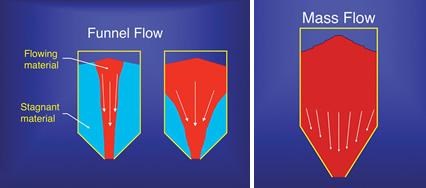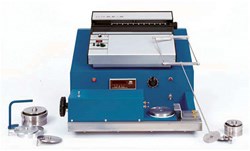What You Don't Know About Solids Flow Can Hurt Your Feeding Efficiency
Plastics processors who want to specify an optimal resin feeding and conveying system need to know about the handling characteristics of their materials.
Plastics processors who want to specify an optimal resin feeding and conveying system need to know about the handling characteristics of their materials. That’s the expert opinion of Jenike & Johanson, Tyngsboro, Mass., a leading supplier of laboratory and engineering services for powder and bulk solid processing (jenike.com). Too often, J&J sources say, processors are not informed about the flow properties of their materials, thus putting their operations at a severe disadvantage and potentially exposing them to quality problems and downtime.
“A quick analysis reveals that there is a lot more than most people realize to understanding how bulk solid materials convey and flow and how that affects the design of a materials handling system,” says Brian Pittenger, senior consultant for Jenike & Johanson. “Processors on the whole know very little when it comes to material flow characteristics.” J&J provides extensive testing services to ensure that bulk raw materials move through a system smoothly. In nearly 50 years in business, the company has tested over 10,000 bulk solids.
“Too often, the design effort consists of sending out bids to equipment vendors with little detail on the solids being handled and a focus on the lowest price,” says Pittenger. Often, processors pay little or no attention to solid handling before a system is installed and then must deal with flow problems when the system starts up, he adds. At that point, they’ve spent their capital budget and they must deal manually with problems at the floor level until they become such a severe quality or product issue that changes are made through the floor operating budget.
Pittenger cites a Rand Corp. study, which reveals that manufacturing plants generally perform poorly in the area of “mechanics of flow,” with most plants never reaching their nameplate capacity. Flow problems give rise to throughput variation and product non-uniformity and, at the extreme, can cause plant downtime, equipment failure, and product rejects.
Tailoring a material handling system to the bulk material’s flow characteristics can influence specifications for a wide range of system components. These include hopper sizes and shapes, conveying line sizes and construction, vacuum pumps, chutes, feeders, dust collection, drive sizing, and operating and data-collection systems.
The key to reliable handling of materials is to design the handling system equipment based on the measured flow properties of the material to be handled. At the time that a handling system is specified and ordered, data on powder flowability are generally incomplete, unavailable, or non-representative of the actual material to be processed, notes Pittenger. Flow property testing should be part of routine pre-engineering work, he says. By obtaining flow properties beforehand, processors can make important engineering decisions.
WHY MATERIALS WON’T FLOW
Plastic resin, either in pellet or granular form, is susceptible to flow problems such as blocking, sticking, erratic flow, inconsistent discharge, poor mixing, and lack of first-in/first-out flow. All of these problems stem from an incompatible combination of solid flow properties and equipment design details.
Two of the most common flow problems experienced in an improperly designed silo, bin, tank, or hopper are no-flow and erratic flow. No-flow from a silo is typically due to either arching (bridging) or rat-holing. Arching or bridging occurs when an obstruction in the shape of an arch or a bridge forms above the outlet of a silo and prevents further discharge. It can be an interlocking arch or a cohesive arch. An interlocking arch, where the particles mechanically lock to form the obstruction, occurs when the particles are large compared with the outlet size of the hopper. A cohesive arch occurs when particle-to-particle bonds form, allowing the material to pack together and obstruct flow.
Rat-holing occurs in a silo when flow takes place within a narrow channel above the outlet, while material on the periphery remains stationary. If the material being handled has sufficient cohesive strength, the stagnant material outside of this channel will not flow into it. Once the flow channel has emptied, all flow from the silo stops.
Erratic flow is often the result of an obstruction alternating between an arch and a rat hole. A rat hole may fail due to an external force, such as ambient plant vibrations, vibrations created by a passing train, or vibrations from a flow-aid device such as an air cannon or mechanical vibrator. While some material may discharge as the rat hole collapses, falling material often gets compacted over the outlet and forms an arch. This arch may break due to a similar external force, and material flow resumes until the flow channel is emptied and a rat hole forms again.
These problems occur in silos where flow takes place through a channel formed within stagnant material. This is called a “funnel flow” pattern, in which some material moves while the rest remains stationary during discharge. Funnel flow occurs when the sloping hopper walls of a silo are not steep enough and insufficiently low in friction for material to flow along them. Under these conditions, particles slide on themselves rather than the hopper walls, and an internal flow channel develops. The desired flow pattern, called “mass flow,” is a the flow pattern when, upon withdrawal of any material, all of the material in a silo moves.
HOW TESTING CAN HELP
Knowledge of solids flow properties is crucial to understanding and solving these costly flow problems. To fix flow problems in existing solids handling systems or to develop recommendations for new systems, Jenike & Johanson uses a scientific approach based on fundamental flow properties of bulk materials, including cohesive strength, internal and wall friction, compressibility, and permeability. At Jenike’s fully equipped laboratories, bench-scale tests on small quantities of materials can be used to design large and complex handling systems that will perform reliably. When evaluating bulk solids properties, it is vital to replicate actual or expected process conditions.
The minimum arching and rat-holing dimensions for a given bulk solid can be determined by measuring the cohesive strength of the material. This is done using Jenike Direct Shear testing methodology (ASTM D 6128). By measuring cohesive strength, the minimum outlet size to prevent cohesive arching or rat-holing can be calculated.
With the direct shear tester, J&J also recommends measuring the internal friction and wall friction. The internal friction may be used to understand how the material shears on itself in an internal flow channel, while wall friction is the shearing along the equipment surface. Both internal and wall friction measurements are used to calculate the necessary hopper angle to achieve flow along the walls and ensure mass flow to eliminate dead and stagnant regions.
Compressibility, or bulk density as a function of consolidating pressure, is another important flow property to be tested. Using a compressibility tester, Pittenger recommends material testing at seven pressure levels. The compressibility value is a useful tool in optimizing material handling systems. It allows processors to take into account feed rate, storage capacity, blend sizes, and mechanical considerations such as torque, horsepower, and loads.
Permeability, or the movement of air or gas through a settled solid bed, is an important property that enables calculation of the limiting discharge rates from hoppers as well as the limits of gas injection in processing vessels. The calculation will affect decisions on hopper size, outlet size, feeder size, and possibly the number of process trains. When dosing additives or fine powders, a consideration of the permeability can help to prevent problems like flooding and uncontrolled discharge.
Related Content
New Pump Rewrites Conveying Rules
NPE2024: Smart Pump technology brings more flexibility and finesse to resin conveying.
Read MoreConair: Going All In on AI
Conveying with Optimizer, Conair’s new AI-based conveying technology stands to be a true game changer for plastics processors.
Read MoreProcessors: Gear Up to Handle More Regrind
Plastics auxiliary and primary processing equipment was optimized for running pellets; here’s how you can adjust to the bulk density differences of flake and regrind in drying, conveying, mixing, feeding and processing.
Read MoreDeflection Elbows Eliminate Streamers for Large Film Processor
New elbows eliminate troublesome streamers to increase productivity at leading blown film processor.
Read MoreRead Next
People 4.0 – How to Get Buy-In from Your Staff for Industry 4.0 Systems
Implementing a production monitoring system as the foundation of a ‘smart factory’ is about integrating people with new technology as much as it is about integrating machines and computers. Here are tips from a company that has gone through the process.
Read MoreBeyond Prototypes: 8 Ways the Plastics Industry Is Using 3D Printing
Plastics processors are finding applications for 3D printing around the plant and across the supply chain. Here are 8 examples to look for at NPE2024.
Read More















